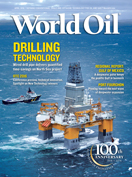Issue: April 2016
Features
The 48th Offshore Technology Conference (OTC) will be held May 2-5, 2016, at NRG Park in Houston, Texas.
The implementation of wired drill pipe (WDP) telemetry on the Martin Linge project was proven successful with quantified time savings and the use of two new technologies, the dual integrated reamer and the seismic-while-drilling tool.
Part 2. This continuation of the VisiTrak application article includes details about reservoir navigation and discussion of the value of ultra-deep resistivity measurements (Part 1 was published in World Oil, February 2016).
While most portions of North America have seen E&P activity shrink to levels that are a fraction of what they were two years ago, work in Newfoundland and Labrador, and Nova Scotia, continues to move forward, due, in part, to long lead times and very promising geology.
A deepwater pulse keeps the Gulf in business, as low prices wreak havoc
Once again, the U.S. federal government is finding a way to take reasonable E&P regulation, via proposed rulemaking, and make it as onerous as possible for the upstream industry.
A lot of pain, little gain seen in ‘16
When it comes to offshore and subsea technology, the operative word is reliability.
This year’s collection of new technologies and new-generation improvements on existing products covers a wide swath of equipment and functions, ranging from expandable liners, liner-hangers and ratchet collars, to submersible pumps, subsea compression and water analysis sensors.
Columns
Bouncing along the bottom
Unbridled hypocrisy
“Exploration is critical to deepwater development”
Cyber-sleuths-come-lately
Reel time
Offshore reality checks
Europe’s energy equation
Tailwinds and headwinds through 2020
Kick ‘em while they’re down
News & Resources
World of oil and gas
Industry at a glance
People in the industry
Companies in the news
New products and services
World Oil's 100-Year Anniversary
At the start of the 1970s, the U.S. had become accustomed to abundant supplies of cheap energy.
In the summer of 1968, Atlantic Richfield established commercial oil production on Alaska’s North Slope with the Prudhoe Bay State No. 1 well.
In March 1971, the Texas Railroad Commission removed the restriction that limited the amount of crude that an operator could produce.
At the start of the 1970s, the U.S. petroleum industry was stuck between a rock and a hard place.
By the start of the 1970s, major oil producers outside of OPEC were struggling to identify geological prospects in onshore provinces, that held sufficient potential to justify large lease plays and exploratory drilling.
In 1942, the U.S. was developing an atomic bomb in Los Alamos, N.M., under the guidance of the Army Corps of Engineers.
Port Fourchon
Quality and quantity matter now, more than ever
The unemployed supply vessels tied to docks throughout southern Louisiana may reflect the near-term prognosis for the deepwater Gulf of Mexico, but the longer-term prospects can be heard in the incessant drone of dredging machines at work in the aquatic arteries crisscrossing Port Fourchon.
Construction should begin this fall on the next leg of the nearly 19-year effort to complete the elevated replacement of the time-worn, and often-impassable, Louisiana Highway 1 (LA 1) corridor from Golden Meadow, La., to Port Fourchon.
Even at $80/bbl oil, the well control rule proposed by the U.S. Bureau of Safety and Environmental Enforcement (BSEE) would reduce Gulf of Mexico exploration by as much as 55% each year, according to a recently released Wood Mackenzie study commissioned by the Gulf Economic Survival Team (GEST) of Thibodaux, La.
ExPert Landing String Solutions of Madisonville, La., is awaiting results of the first application of the industry’s only modular buoyancy system, engineered to safely land the long strings of heavy-walled casing required in most ultra-deepwater Gulf of Mexico wells.



